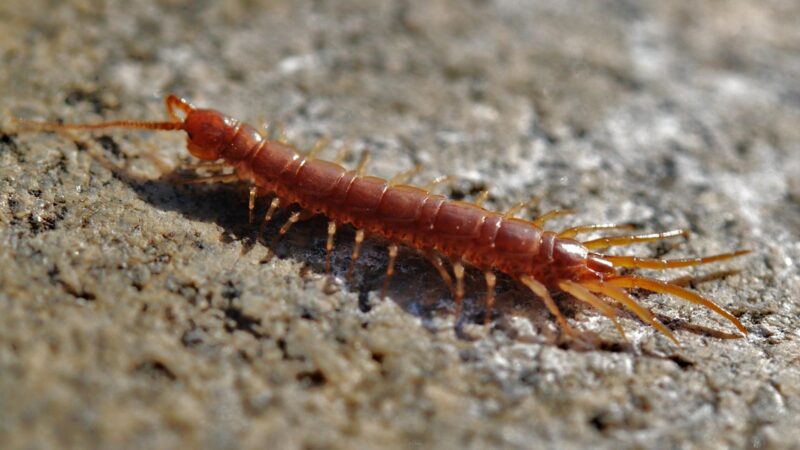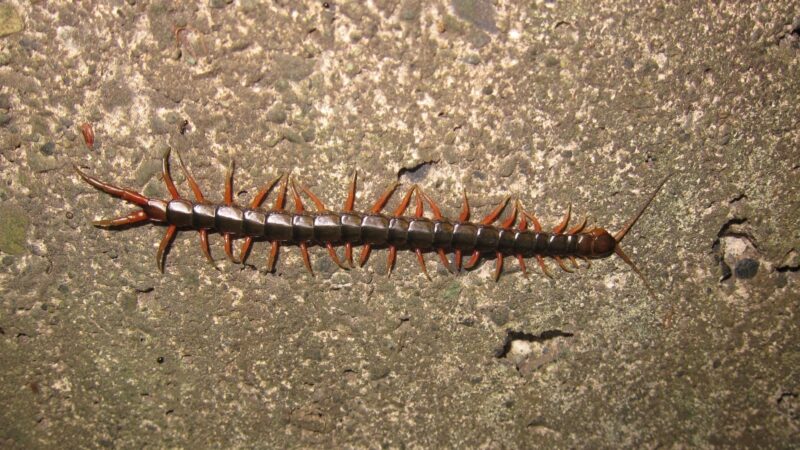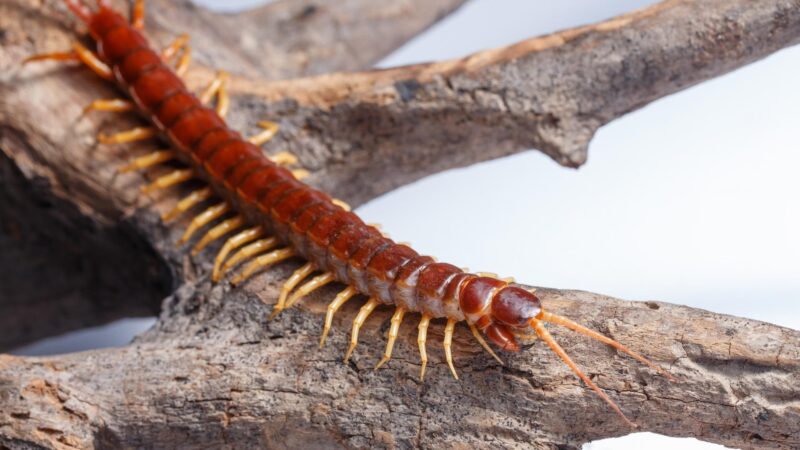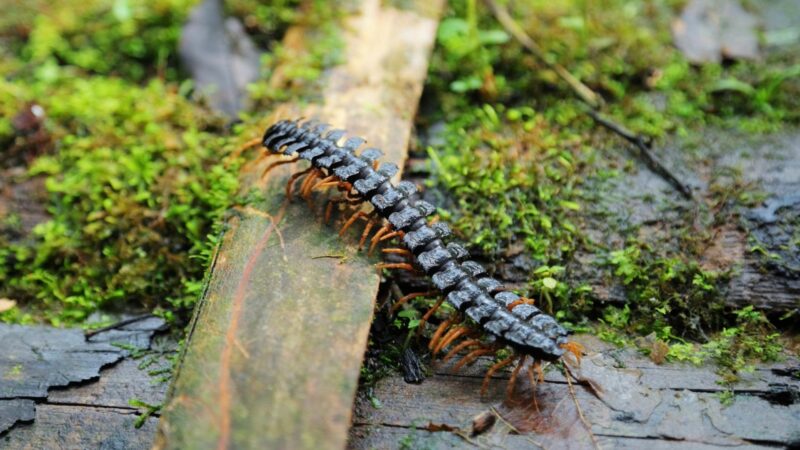Centipedes are generally not harmful pests. However, if they live close to humans, issues can arise. They can occasionally bite humans and cause mild discomfort, redness, and swelling.
How to know if you have a centipede infestation? There are no direct signs of a centipede infestation except when you see them yourself. This is because they don’t typically generate home damage and don’t leave any trails either. So, if you see yellowish crickets with three dark upper stripes on their legs and usually feel them getting punctured at night, there’s a high chance that you have a centipede infestation.
By further reading this guide, you will know more about centipedes, including the things they are attracted to, ways to manage them, and the methods to get rid of them. So, let’s start!
Table of Contents
What Attracts Centipedes to Your House?

Various things attract centipedes to your house, such as:
1. Insects That Live in Your Area
Centipedes often arise in many yards to look for insects to eat. They are greedy hunters that can eat nearly any bugs, such as crickets, moths, pillbugs, flies, spiders, ground beetles, cockroaches, and silverfish.
If you have these insects in your home, make sure to get rid of them or call a pest control professional to deal with the issue. This way, you can prevent these arthropods from infesting your property.
2. Ideal Shelter
Just like any other insects, centipedes are also attracted to places where they can live comfortably. They particularly like dark and silent places, such as:
- Woodpiles
- Under the rocks
- Old rubber tiles
- Cement blocks
- Under rotting woods
Furthermore, these arthropods can also live comfortably within gaps and crevices, construction materials, and old furniture outdoors. Ultimately, the less disturbing the place is, the more it becomes an ideal place for them.
3. Moisture
One interesting fact about centipedes is that they constantly search for water to rehydrate themselves.
Just like most pests, centipedes search for water sources to rehydrate themselves. They can’t survive in places that are dry and always look for moist places to live and thrive.
4. Warmth
Another thing that attracts centipedes to houses is the warmth of the place. This condition helps these arthropods reproduce and live comfortably within your home.
These often go through wall cracks, windows, door gaps, and drains. So, to prevent this from happening, make sure to fix any tiny holes or cracks in your place. Also, ensure that all your windows and doors are sealed to prevent them from coming over.
5. Uncovered Trash Bins
As explained, centipedes are attracted to various insects, including flies, roaches, and mice. And these pests are drawn to trash, so if they come to your area, centipedes will also get themselves into your place to have their insect meals.
To prevent this, make sure that your trash bins are tightly covered to avoid attracting any garbage-loving pests to your area.
Do Centipedes Infest?

Centipedes infest homes with good food sources, moisture, and an ideal environment for living. So, if the conditions of your place have these elements, there’s a high possibility that centipedes will infest there.
How Many Centipedes Is an Infestation?

Unfortunately, there’s no exact number for determining a centipede infestation. This is because these arthropods don’t leave any signs of their existence except when you see them yourself.
Does One Centipede Mean More?
Since centipedes are nocturnal creatures, you may not find a lot of them during the day. Nonetheless, if you see at least one centipede in your place, there’s a high chance that there are many of them nearby.
Signs of Centipede Infestation

When it comes to centipede infestation, you can’t find any signs of them except by seeing them for yourself. It can be hard to pinpoint an infestation since they don’t leave any trails of themselves.
However, if you see yellow with dark outer stripes crawling arthropods with 15 pairs of legs that look like antennae, then it’s a confirmation of a centipede infestation.
Furthermore, if you see many pests within your area, such as bedbugs, ants, spiders, etc., you could also be dealing with centipedes. This is because centipedes are attracted to the presence of these insects.
Should I Leave House Centipedes Alone?
If the centipedes aren’t making any trouble for you, then it’s worth considering leaving them alone. This is because they kill other pests that can cause health and structure issues, such as flies, moths, roaches, termites, and bedbugs.
Are Centipedes Good for Anything?
Centipedes are known for eliminating several harmful pests in your home, which is a very good thing. Some of the unwelcomed insects they consume are moths, roaches, flies, termites, and silverfish.
They make use of their several pairs of legs in scooping up various bugs after they puncture their victim with their venom using their two front legs.
Where Do House Centipedes Lay Eggs?
Centipedes usually lay their eggs in damp areas, such as bathrooms, attics, cellars, beneath the firewoods, and even in closets!
How to Control Centipede Infestation?
To help manage centipede infestation within your home, here are some of the things that you can do:
1. Reduce moisture in your area.
Centipedes love to live in wet environments. Hence, it’s best to ensure that there are no leak pipes or any standing water in your area.
You can also use a dehumidifier in your basement to keep it dry and consider using exhaust fans for attics and bathrooms for the same purpose.
2. Remove any clutter.
Centipedes love clutter since it gives them protection and the ideal space to live. So, you must start decluttering your crawl spaces, attics, and basements to limit their hiding places. Also, move the pile of grass clippings, leaves, and firewood far enough from the house.
3. Get rid of their food source within your property.
Another way to control centipedes in your property is to get rid of the food sources within your property. This means eliminating insects they love to eat, such as spiders, silverfish roaches, etc.
4. Seal all possible entryways.
Sealing holes, gaps, and cracks in your house is another way to prevent these arthropods from coming into your home. Also, if there are tears on your screen, ensure to repair them right away before they become an access point for the centipedes.
5. Make a barrier.
Another way to deal with centipedes is by creating a barrier using an insecticide killer like Ortho Home Defense Insect Killer to window casings, doors, along the baseboards, and outdoors within the boundary of your house.
How to Get Rid of Centipede Infestation Naturally?
If you dislike using chemicals, you can get rid of centipedes naturally with the following:
1. Boric Acid
Boric acid is another natural way to eliminate the centipedes in your house. This item can dehydrate the centipede’s exoskeleton upon touching the boric acid powder.
To apply, sprinkle boric acid into the affected area or directly into the centipedes.
2. Dehumidifier
As mentioned earlier in this guide, centipedes thrive in wet conditions. Therefore, to prevent a centipede infestation in your place, consider using a dehumidifier in the moist areas of your home.
In addition, get rid of the usual excess moisture in the bathroom areas by using exhaust fans.
3. Cayenne Pepper
Another way to manage centipedes naturally is by using cayenne pepper. This household item contains capsaicin that generates intense heat, warding off centipedes right away.
To apply, sprinkle a generous amount of cayenne pepper into all possible entryways or directly to the affected site.
4. Sticky Traps
Sticky traps have always been known to catch various creeping insects effectively. So, take this advantage and use sticky traps in dealing with your centipedes’ issues.
Just put the sticky traps in the various corners of your house, just right along the floorboards. The unsuspecting arthropods will get stuck in the trap while searching for food.
5. Diatomaceous Earth
Using food-grade Diatomaceous Earth (DE) is one of the best ways to get rid of centipedes naturally. This product works by dehydrating insects that touch the DE powder.
Just sprinkle DE to the areas where you usually see the centipedes crawling and wait for the result. Reapply as needed.
What Causes a Centipede Infestation?
There are always reasons behind every pest infestation, and centipede infestation isn’t an exemption. So, here are some of the reasons why you have a centipede infestation:
1. Clogged or Cracked Gutters
Gutters are essential in keeping the waters away from the home’s foundation. But, wear and tear can happen, especially if the gutters are old.
When that happens, the foundation will start absorbing water, which will lead to cracks. This will give centipedes ideal freeways to get inside your house.
So, make sure your gutters are in good condition to avoid having centipedes within your home.
2. Leaky Water Pipes
Where there are leaks, there are also centipedes. This is particularly true due to the moist-loving nature of these arthropods.
So, ensure checking your faucets, pipes, and other water sources if you don’t want centipedes crawling on your place.
3. Small Cracks or Holes Around the Home
Cracks or holes serve as an entry point for centipedes, so if you find any gaps in your place, seal them right away. As much as possible, inspect for cracks around door and window frames, skylights, plumbing fixtures, and outdoor wall base.
Sealing all the cracks or holes keeps the centipedes and other pests outside, which will bring a lot of you a lot of relief as a homeowner.
4. Swarm of Insects
When the vicinity of your home has a lot of various insects, you can expect that centipede will make sure to be at your place. This is because centipedes are attracted to insects and consume some of them, such as bedbugs, roaches, silverfishes, spiders, etc.
How Long Does Centipede Infestation Last?
Given the right conditions, female centipedes can live up to five years. In addition, they also breed multiple times, so there’s no exact time when the infestation will last.
Summary
Centipedes are not harmful to humans. They also have good use in eating up harmful bugs, such as termites and roaches.
But, if you find yourself getting bugged by centipedes, you can use the given methods in this guide to deal with these arthropods.